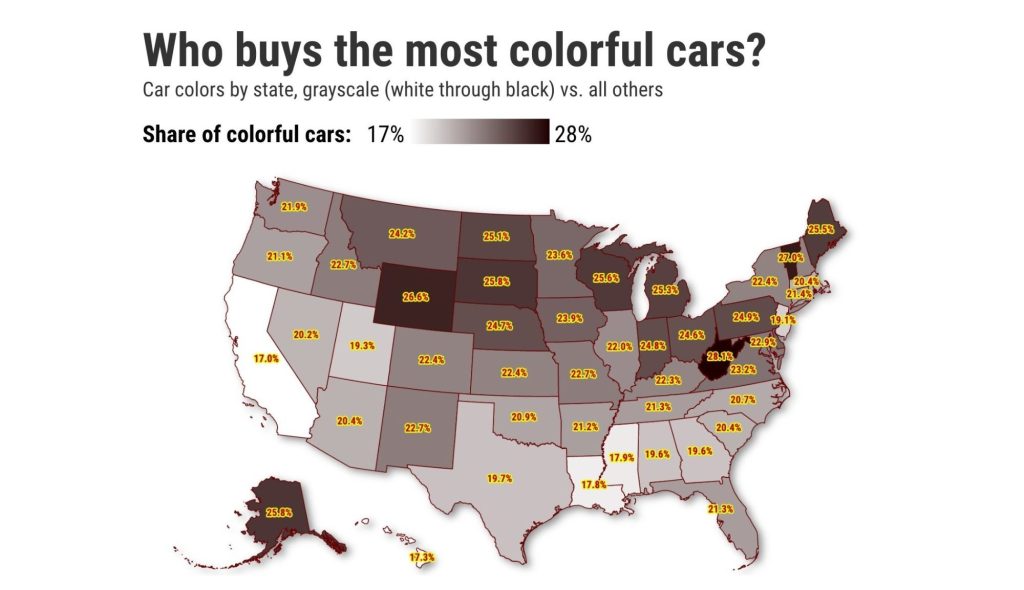Why is a state with a taste for eclectic vehicles so boring when it comes to the colors of the transportation?
Your eyes tell you California drivers prefer the grayscale — from white to black with gray and silver in-between. My trusty spreadsheet, looking at a study by car-search website Iseecars.com, tells me no state is more sedate with color selection.
This research says 30% of California cars are white — the highest share among the states. Black-gray-silver makes up 53% of vehicles statewide — the same as the rest of the nation. That leaves only 17% of California autos in the “colorful” category, the lowest among the states and below the 22% U.S. share.
Lansner’s mailbag: Is California 3rd worst state, 6th best or tied with Texas?
/*! This file is auto-generated */!function(c,l){“use strict”;var e=!1,o=!1;if(l.querySelector)if(c.addEventListener)e=!0;if(c.wp=c.wp||{},c.wp.receiveEmbedMessage);else if(c.wp.receiveEmbedMessage=function(e){var t=e.data;if(!t);else if(!(t.secret||t.message||t.value));else if(/[^a-zA-Z0-9]/.test(t.secret));else{for(var r,s,a,i=l.querySelectorAll(‘iframe[data-secret=”‘+t.secret+'”]’),n=l.querySelectorAll(‘blockquote[data-secret=”‘+t.secret+'”]’),o=0;o And when that same data was sliced by 50 big metro areas, California had four regions ranked highly among the least-colorful car towns – Southern California was No. 1 (with only 16% colorful cars); San Diego was No. 2 (17%); Sacramento was No. 3 (18%); and the Bay Area No. 6 (19%). Karl Brauer is Iseecars’ car sales guru who lives in Orange County. Like me, he’s oddly bothered by the wave of bland colors on streets and freeways. “I always remind myself that for every brightly-colored car I see and note – wow, look at the fire-engine-red Ferrari! – I generally ignore the sea of black, white and silver cars constantly passing me by,” he says. His family’s agglomeration of vehicles reinforces his colorful thoughts. It’s two blue, two red, his son’s black car (“bought it for CHEAP”) — and his gray convertible (a more complicated story). That color portfolio aligns with the last five cars I bought — orange, blue, green, red — and white (I liked the multi-toned interior). Brauer’s contrarian thinking is refreshing. And not just because I, too, tally in my head all the drab car colors passing by or filling parking lots. You see, far too often industry experts simply buy into the common wisdom — even if the patterns seem odd. “Honestly, when I drive around I’ll often do my own ‘okay, find a non-grayscale car’ moment while waiting at a light or cruising on the freeway. Usually, the result is pretty depressing,” Brauer says. Brauer put personal preferences aside to offer some business reasons why Californians own less-than-colorful cars. “A lot of trucks and SUVs are purchased by businesses, and they love white because it’s a neutral starting color for adding company logos and graphics, and it tends to hold up well and not show dirt,” he notes. “A truck or SUV on the road is very likely white simply because that’s seen as the most practical color by business owners.” And you know with Californians, there’s always a money angle. “Individuals purchase ‘safe’ colors to avoid challenges when it comes time to sell,” Brauer says. “They feel like everyone will buy a black, white or silver car and they don’t want to work hard to find the rare buyer seeking a creative color. Many dealers order ‘safe’ colors when stocking their lots for the same reason.” Californians do buy pricey stuff, so color matters. But Brauer wonders if the conservative choices add up. “I think there is a huge self-fulfilling prophecy factor where you have both dealers and consumers assuming that everyone likes — or, at least doesn’t dislike — these safe colors,” he says. “So everyone buys them assuming everyone else prefers them. But if you ask these people if they genuinely prefer black, white or silver cars on a personal level, many say ‘no but everyone else does,’ so they go along to get along.” The customer is always right, yes? Well, the uncommon colorful car may hold its resale value better. Consider an Iseecars study of depreciation rates across the nation by color that suggests rarity sells. The hard-to-find yellow vehicle — a shade often found on sports cars — fared best, retaining 95% of its value after three years. Next came orange at 89%. Purple, red, green, blue, gray and beige were at 86%. Silver was at the national average of 85% followed by white and black at 84%. And by this math, if you care about resale value but want a colorful drive, don’t get gold (83%) or brown (82%). Publishing such trends reveals Brauer’s intense questioning of car-color preferences. “These boring colors hurt resale value,” he says. “But I know I’m alone. I see all the premium cars driven in south Orange County and it feels almost like a uniform. The white Mercedes-Benz. The black Audi. The silver BMW. I’m not sure how these people don’t feel like they are part of some dystopian science fiction novel. But I do love throwing my red and blue cars into their world, just to mix things up a bit.” Look at the Top 10 “most colorful” metro areas by car ownership from the Iseecars study. Harrisburg, Pa., was No. 1 then Pittsburgh, Indianapolis, Detroit, Cleveland, Akron, Ohio, Cincinnati, Louisville, Milwaukee, Grand Rapids, Mich. and Columbus, Ohio. As someone who lived his first three decades in the nation’s northeast quadrant, I know these cities have fairly dreary climates. Unlike sunny California, the weather is often measured in shades of gray. Maybe they need colorful cars to brighten the scenery. Jonathan Lansner is the business columnist for the Southern California News Group. He can be reached at jlansner@scng.com
Business of grayscale
Rarity matters
Gray skies










